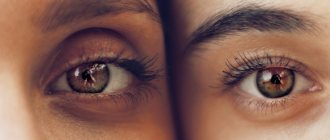Increasing the incision of the eye along the line of the upper and lower eyelids is called canthoplasty, from the Greek cantos - angle. Blepharoplasty also works on the eyelids, but the purpose of the intervention is different - to hide signs of age-related changes, tighten overhanging skin folds, and get rid of fatty hernias. The main task here is to make the look visually more open and the angle of the neckline graceful. As a result, the impression of a youthful open gaze is created, an emphasis is created on it, the depth and color of the iris is emphasized. Canthoplasty is often combined with blepharoplasty to obtain a complex effect: rejuvenation and aesthetic perfection.
Correction methods
You can tighten the skin of your eyelids using plastic surgery and non-surgically. The method of correction in each case is selected individually, depending on the condition of the skin around the eyes and the health of the body.
1. Non-surgical eyelid blepharoplasty is considered the most painless and atraumatic correction method. In addition, it has a minimum of contraindications and possible complications.
There are two methods:
- Injection. Medicines are injected under the skin to make it smoother and more elastic.
- Hardware. Includes: laser, ultrasound, thermage, thermolifting, electro-, Raylife and DROT therapy.
Contraindications:
- pregnancy;
- malignant neoplasms;
- presence of a pacemaker;
- infectious and autoimmune diseases;
- hemophilia;
- inflammatory diseases of the skin around the eyes (styre);
- diabetes.
After non-surgical blepharoplasty of the lower or upper eyelids, there are no scars left. The effect lasts from 1 year (injections) to 7 years (laser procedures).
However, the non-surgical method eliminates only minor defects: shallow wrinkles, small excess fat.
If the problem is more serious or the patient is over 50 years old, it is more advisable to resort to plastic surgery.
2. Plastic surgery. Excess fat tissue and skin are removed surgically. Incisions are made in the natural folds of the skin so that the scars are not noticeable. In the lower eyelid area, it is possible to eliminate hernias through the mucous membrane of the eye, that is, without incisions.
Contraindications:
- problems with blood clotting;
- taking anticoagulants;
- suffered a heart attack or stroke;
- retinal detachment;
- heart problems;
- diabetes;
- oncological tumors;
- AIDS;
- systemic diseases;
- chronic kidney or liver failure;
- menstruation;
- period of pregnancy and lactation.
Nonspecific factors due to which surgery cannot be performed include:
- inflammatory processes of the skin around the eyelids;
- Graves' disease;
- dry eye syndrome;
- deep scars at the temple;
- myopia;
- conjunctivitis;
- blepharospasm or glaucoma.
How to enlarge the eye section
In the literal sense of the word, it is physiologically impossible to make it larger - the size is determined genetically. The doctor can:
- excise part of the skin of the upper eyelid;
- remove the fold above the upper eyelid (more common in Asian faces);
- do a lift along the eyelash edge;
- change the shape and diameter of the palpebral fissure by working with the eyelids.
In each case, the surgeon’s manipulations are variable. Schematically, the procedure looks like this.
- Anesthesia is performed (local anesthesia or general anesthesia).
- An incision is made.
- The necessary tissues (skin, fat, muscle) are excised.
- Cosmetic stitches are applied.
Recovery period after surgery
Sutures after blepharoplasty are not removed, as special absorbable threads are used.
In the first days after surgery, swelling is observed: this is a natural reaction of the body. Swelling can be reduced by applying cold compresses.
Patients must also adhere to certain rules for speedy rehabilitation after blepharoplasty:
- eliminate stress on the eyes and eyelids (reading, computer, TV, contact lenses, bright light);
- give up smoking and alcohol (to avoid major swelling), and salty foods;
- sleep only on your back using a high pillow;
- replace contact lenses with glasses for a month;
- try not to tilt your head;
- protect eyelids and eyes from external influences (wind, bright light, cosmetics, soap);
- wash your face with chamomile decoction;
- avoid baths and saunas;
- carefully perform special eye exercises.
The rehabilitation period lasts from 7 to 10 days. A person can return to work after 2 weeks. The result will be noticeable immediately after the operation, but the final effect will become obvious only after a month. Following the rules of eyelid skin care will allow you to preserve it for as long as possible, sometimes this period is more than ten years.
Nuances of the procedure
The period for performing a simple intervention is half an hour; with combined techniques (when several tasks are performed simultaneously), the time increases to 2 hours.
When the patient can leave the clinic largely depends on the type of anesthesia. With local anesthesia - after 3 hours, with general anesthesia after 5-6 hours or the next day.
How much surgery to enlarge the eye shape costs depends on the chosen technique and the scope of the intervention. The price is negotiated before manipulation and remains unchanged.
When to do blepharoplasty: expert opinion
Plastic surgeons recommend doing the first procedure at the age of 35-40. At this age, the aging process has already begun, and timely surgery will make it possible to avoid scars - marks on the skin will remain almost invisible.
Since blepharoplasty stops aging only temporarily, the operation will need to be repeated. The best age is 50 and then 65 years.
To understand what results you will get, you can read reviews about blepharoplasty on forums. Almost all patients are satisfied with the result. The main thing is to approach the task responsibly and choose a good specialist.
You can get advice from the best surgeons in Moscow at the SM-Plastika plastic surgery clinic. The “Our Experience” section will introduce you to the results of such operations.
Eye enlargement surgeries: surgical correction options
Modern microsurgery technologies make it possible to perform extremely technically complex operations without visible marks on the skin.
For example, canthoplasty is performed using an endoscope and leaves no scars on the skin. Microsurgical instruments increase the accuracy of manipulations, reduce the degree of tissue injury and the risk of complications, and open new horizons for aesthetic remodeling. Changing the shape of the eyes is a group of operations, the purpose of which is to improve appearance by changing the inclination, increasing the transverse or vertical size of the palpebral fissure. The fashion for such operations came to us from the east. As you know, in the countries of Southeast Asia, in particular in Japan, heroes with large, wide eyes are popular. Many people strive to be like their favorite heroes, and plastic surgeons are ready to help patients make their dreams come true.
Europeanization of the eyes: Sangapuri plastic surgery
One of the first operations to increase the size of the eyes was Sangapuri plastic surgery. Strictly speaking, this plastic surgery pursues slightly different goals, however, surgical intervention changes not only the structure of the upper eyelid, but also the size of the palpebral fissure.
The purpose of the operation to Europeanize the eye shape is to create the so-called supraorbital fold. Folds of the upper eyelid are characteristic of representatives of the European race. In people of the Mongoloid race they are absent or extremely weakly expressed. In addition, they have more pronounced adipose tissue of the upper eyelid, plus there is an epicanthus - an additional fold of skin in the area of the inner corner of the eye.
Epicanthus poses a serious aesthetic problem because it visually widens the bridge of the nose and increases the distance between the eyes. Because of this fold, facial features often become disproportionate and less attractive. Such individual characteristics do not correspond to the canons of beauty, as does a “heavy” upper eyelid with an increased volume of fat and the absence of a supraorbital fold.
To become more attractive, many representatives of the Mongoloid race decide to change their eye shape through surgery. During the Sangapuri operation, the plastic surgeon removes excess fatty tissue, performs skin grafting to form a fold of the upper eyelid, and removes the epicanthus. As a result, the transverse size of the palpebral fissure visually increases. The look becomes open, the eyes become wide and expressive, the face becomes beautiful, more attractive.
Contraindications
Blepharoplasty is an operation that can solve serious aesthetic problems. However, it is not performed if there are the following contraindications:
- Inflammatory and other pathological processes around the eyes;
- Oncological neoplasms in the body;
- Diabetes;
- Systemic blood diseases;
- Pregnancy, breastfeeding period;
- Irritable eye syndrome;
- Increased intracranial and intraocular pressure;
- Persistent arterial hypertension.
Upper eyelid blepharoplasty with a short incision is a sham!
Capital specialists offer many proprietary techniques, as they say, “not all of them are equally useful”! Type in the search bar: blepharoplasty Moscow! You'll probably see ads about short seams.
Blepharoplasty in Moscow can be performed using a technology where the shortened incision does not extend beyond the fold of the upper eyelid. Such an operation always leads to a “rounding” of the eye - these are the laws of geometry that simply cannot be violated without resulting in a “gathering” on the upper eyelid and a round, rather than almond-shaped, incision.
But we women want everything at once! We need eyes like Cleopatra's and no scars around them! I want to make you happy - this is possible, but not due to a shortened incision (it does not make it possible to completely remove excess skin and restore the shape of young eyes), but due to fine surgical technique and the use of an invisible suture method.
I will tell you in more detail next time how blepharoplasty of the upper and lower eyelids uses these surgical technologies.
Almond-shaped eyes (Cleopatra's look).
Blepharoplasty of the upper and lower eyelids has two main goals:
- Rejuvenation of the eye area (removal of excess skin and fat on the eyelids))
- Restoring the shape of the eyes as they were in youth (lifting the upper and lower eyelids).
Of course, women are primarily concerned about such obvious problems as sagging skin folds or fatty hernias under the eyes, but as a result of the operation they want one thing - to return the eyes to their previous shape without distorting the cut and rounding the shape.
The task of recreating the almond-shaped shape of the eye with a slightly raised outer corner is solved by blepharoplasty of the upper eyelids. To achieve this, surgeons make a long incision in the upper eyelid.
The photo shows before and after 7 days. I use special adhesives on the sutures, which allow the sutures to be removed already on the 2nd day after the operation and subsequently make the suture almost invisible
The angle and geometry of the incision are calculated specifically for each patient. In addition to removing excess fat and stretched skin, the surgeon will perform minor tightening of small muscles and ligaments to lift the drooping outer corner of the eye. Blepharoplasty of the upper eyelids with restoration of the almond shape of the eyes requires certain experience and skill. It is usually performed by specialists in the field of facial plastic surgery (rather than general surgeons). It is not always possible to restore a beautiful shape by limiting yourself only to lifting the upper eyelid. Very often, with age, so-called “fatty hernias” form under the eyes. They not only form bags and wrinkles under the eyes, but also “round” their shape. Sometimes even a twist occurs. In this case, blepharoplasty of the upper and lower eyelids is performed. One of the important goals of such correction is to restore the beautiful shape and shape of the eyes.
View this post on Instagram
7 days after upper eyelid surgery #plastic surgeon #plastic surgery #blepharoplasty #upper eyelids #plasticsurgery #plastymoscow
Publication from Ekaterina Kudinova (@doctor.kudinova) Sep 24, 2018 at 7:03 PDT
Not only older patients, but also young girls want to have eyes “like Cleopatra”; this also requires blepharoplasty, and Moscow is exactly the place where you can find the right specialist who will select the relevant method for each case.
In addition, young patients sometimes turn to plastic surgeons with a request to change the Asian shape of their eyes or make their eyes larger.
Complications after blepharoplasty
In preparation for blepharoplasty, patients should provide information about their medical conditions, such as hypertension, diabetes, bleeding disorders, keloid or hypertrophic scars, allergies, heart or thyroid problems, and medications they are taking. Patients taking aspirin or other anticoagulants should stop taking them for 5 to 10 days.
Patients taking vitamin E, hormones, contraceptives or herbal preparations should stop taking them, if possible, 2 weeks before surgery, as otherwise there may be a prolonged resolution of swelling after surgery and an increased risk of bruising.
Before surgery, you should pay attention to the presence
- strabismus,
- orbital or secular asymmetry,
- asymmetry of the orbital fissure,
- exophthalmos,
- concomitant eyelid lesions,
- ptosis and eyebrow asymmetry,
- true ptosis of the eyelids,
- weakness of the eyelids,
- dry eye syndrome and
- allergic diseases of the eyes and eyelids.
Some of these findings, such as eyelid asymmetry, different palpebral fissure widths, and exophthalmos, if present preoperatively, may increase after blepharoplasty and patients should be informed of this prior to surgery.
All consequences after blepharoplasty surgery can be divided into
- complications after upper eyelid blepharoplasty
- complications after lower eyelid blepharoplasty
- complications after transconjunctival blepharoplasty of the lower eyelids
Possible complications afterupper eyelid blepharoplasty
Possible complications afterlower eyelid surgery
|
Now let's take a closer look at these complications.
Bleeding during surgery
Intraoperative manipulations during surgery are closely associated with early postoperative complications. Some of these complications should be defined as expected side effects rather than actual complications (ie, bruising, swelling).
Patients who undergo surgery under local anesthesia but with intraoperative intravenous analgesia have been found to be less susceptible to postoperative swelling.
Sedation reduces patient stress during surgery and therefore the release of stress hormones from the adrenal glands. Epinephrine, cortisol and norepinephrine, the three most important stress hormones, can influence tissue response during surgery, and sedation goes a long way toward reducing this effect.
Immediately after the operation is completed, ice compresses are applied to the eyelids. It is recommended to use them within 48 hours after surgery. Excessive bruising and ecchymoses may occur in patients who do not follow the plastic surgeon's recommendations.
Exercising, increased blood pressure during exercise or other activities, restless sleep, or consuming heavy meals and alcohol during the first week after surgery are also possible causes of complications.
Excessive skin removal during upper blepharoplasty
Correctly marking the skin before surgery is a very important step to prevent aesthetic and functional postoperative complications.
The minimum incision distances from the border of the eyebrow and the lash line (the existing upper eyelid crease) must be strictly observed. This will prevent postoperative lagophthalmos and subsequent conjunctivitis or keratitis.
Temporary lagophthalmos may occur within 24–72 hours after surgery due to swelling of the upper eyelid. Excessive trauma to the levator, levator aponeurosis, or preaponeurotic fat pad can lead to eyelid retraction and lagophthalmos.
Excessive resection (removal) of fat during upper blepharoplasty
The current trend in blepharoplasty is to maximize tissue preservation and should always be done during surgery.
“Sunken eye syndrome” (sunken, sunken eyes) observed in elderly patients who have undergone excessive fat removal with upper blepharoplasty in the past should be strictly avoided.
The patient in the photo below had surgery elsewhere at a younger age and has recessed eyes after blepharoplasty due to excessive removal of fat and skin.
A strip of sclera of the lower eyelid is also noted. Note that the upper eyelid crease is raised unnaturally high due to excessive resection (removal) of fat, retraction and scarring, including the eyelid structures and levator aponeurosis.
In the lower photo, lipofilling was performed in the upper and lower eyelids, which restored the fullness and normal position of the fold of the upper eyelid and eliminated the scleral strip in the lower eyelids.
Lipofilling of the eyelids is a procedure that allows you to very effectively correct sunken eyelids.
To avoid the complication of over-resection of fat, it is necessary to remove fat during surgery in small portions, continuously assessing the residual amount by applying pressure to the eyeball with your fingers, before each attempt to remove fat.
The patient in the photo above has initially heavy upper eyelids with extensive excess skin, a lateral hood and a recess at the root of the nose (top photo) after a well-performed blepharoplasty turns into upper eyelids with good filling, a well-defined eyelid crease and a natural appearance. (bottom photo) Patient before and 4 years after surgery. The postoperative picture shows conservative removal of skin and fat, resulting in a very pleasant and natural appearance in the postoperative period.
Insufficient fat resection during upper blepharoplasty
The residual amount of fatty tissue leads to a bulge after surgery, and this, accordingly, leads to irritation of the patient.
Many of them seek repeated surgery for correction.
Overcorrection in lower blepharoplasty
Transconjunctival access using a CO2 laser for lower eyelid blepharoplasty has dramatically reduced the risk and incidence of complications of excessive resection, manifested in the form of depressions (recessions) or ectropion of the lower eyelid.
Additionally, the expanded indications for this technique for patients with more excessive skin laxity and wrinkles that have previously required percutaneous skin excision minimize complications such as
- rounding of the lateral corner of the eye,
- retraction of the lower eyelid,
- formation of a scleral stripe and
- ectropion.
Excessive resection of lower eyelid fat should be avoided to avoid eye retraction. Preventive measures are applied in the same way as for upper blepharoplasty. Fat is removed in portions and residual fat is continuously assessed. This is a strict requirement for lower blepharoplasty. Laser fat evaporation is also a preventative treatment for patients who require minimal fat removal.
Underresection of lower eyelid fat pads should also be avoided. This will lead to patients complaining that they have bags under their eyes after blepharoplasty.
Insufficient skin resection
Excision of the skin during upper and lower blepharoplasty is a very important stage of the operation. The use of a laser has minimized complications associated with excessive skin resection during lower blepharoplasty using a transconjunctival incision.
In my experience, patients complaining of insufficient skin removal and aesthetically unsatisfactory results due to excess remaining skin after blepharoplasty primarily focus on the appearance of the upper eyelid, namely the lateral hood that can occur in such cases. If this complication occurs, it is necessary to perform corrective surgery to eliminate the asymmetry.
In the lower eyelid, moderate excess skin after blepharoplasty is usually not irritating to the patient and can be treated with a variety of non-surgical methods such as peeling or laser resurfacing.
Strabismus
Although this is a very rare complication, special care should be taken to avoid injury to the inferior oblique muscle during lower eyelid fat removal. If damaged, strabismus may develop.
Round eye
Risk of lower eyelid retraction (eversion)
is significantly reduced due to the transconjunctival approach and avoidance of aggressive dissection.
In open blepharoplasty, rounding of the lateral corner of the eye
, a very annoying complication that gives an unnatural sad look.
One of the reasons for the formation of such a complication (in addition to excessive skin resection) is the close proximity of the upper and lower skin incisions during blepharoplasty. During wound healing and scar formation, two opposing traction forces are created, which lead to the formation of a rounded canthal angle. Therefore, the incision of the upper and lower eyelids should separate a skin flap measuring at least 5 mm.
Scars after blepharoplasty
The skin of the eyelids has excellent healing ability. However, eyelid skin incisions must always be planned accurately and carefully.
In my practice, I have never had a hypertrophic or keloid scar on the eyelids of my patients, but sometimes there was widening and hypopigmentation of the incision line. Patients with darker skin types may be more prone to this complication.
In female patients, camouflage with cosmetics can make this minor problem invisible. However, we should not rely on such decisions, and specific measures should be taken during surgery to improve the quality of the postoperative scar.
When suturing the skin of the upper eyelid, you should not use any subcutaneous absorbable sutures, since the risk of the body reacting to the sutures is high. Prolene suture is ideal for suturing the skin of the eyelids.
However, more important is the correct placement of the incision, which should be located in the existing eyelid crease.
It is recommended to avoid using a laser to make skin incisions.
Redness of the scar during the first 2 months is an expected consequence of the healing process and patients should be informed during the initial consultation.
In patients who do not follow the surgeon's recommendations in the postoperative period, suture dehiscence of the upper eyelid may occur. If the discrepancy is large, surgical correction is necessary. Minor discrepancies can be treated conservatively with Steri Strips and topical eye ointments to speed up the healing process.
Epidermoid cysts
A fairly common complication with upper blepharoplasty is epidermoid cysts.
which may appear along the incision line after surgery. They are the result of implantation of epidermal elements into the dermis. Treatment involves careful removal of the cyst.
Post-inflammatory hyperpigmentation
May occur in patients with darker skin types, especially if a laser was used to cut the skin.
With a transconjunctival incision of the lower eyelid, no sutures are required, since the healing process is very fast and proceeds without complications. In less than 72 hours, the incision will heal completely, provided there has been no trauma during this time.
Laser eyelid skin resurfacing can lead to post-inflammatory hyperpigmentation. This occurs mainly after the erythema period has ended (30–45 days after) and can last for months. Darker skin types, Fitzpatrick IV – VI, are more susceptible to hyperpigmentation after laser skin resurfacing.
Treatment of hyperpigmentation mainly consists of the use of drugs consisting of hydroquinone in combination with glycolic acid, moisturizing agents and corticosteroids. Treatment must be intensive to avoid worsening hyperpigmentation. The use of sunscreen is mandatory during treatment.
Granulomas
May rarely form along the transconjunctival incision, in the early postoperative stage.
In my practice, this complication occurred in two patients. After anesthetizing the conjunctiva with local anesthetic eye drops, they performed excision of the granuloma with thin scissors.
This complication most often occurs in patients who do not follow postoperative recommendations and use contact lenses.
Occasionally, granulomas may develop in incisions where excessive swelling prevents firm contact of the incision edges in the first 24 to 48 hours after surgery. This incomplete contact of the wound edges can lead to the progressive formation of a granuloma, which the patient may not notice until several weeks later, due to the appearance of foreign body symptoms in the eye.
With open lower blepharoplasty, the amount of skin excised and the correct location of the incision are of primary importance. Postoperative lower eyelid retraction
directly related to the above two factors.
Dry eye syndrome
Dry eye syndrome, also known as keratoconjunctivitis, is an eye disease characterized by low tear production. According to some estimates, between 17 and 30% of people have dry eye syndrome at some point in their lives.
Symptoms of dry eye are common after blepharoplasty, and the risk of developing these conditions may be increased with intraoperative canthopexy, postoperative temporary lagophthalmos, simultaneous upper and lower blepharoplasty, and percutaneous approaches that compromise the orbicularis oculi muscle.
Patients with a preoperative history of dry eye or eyelid laxity may be at greater risk of developing dry eye syndrome after surgery.
Retrobulbar hematoma and vision loss
Deep orbital hemorrhage with vision loss is a very rare but existing complication of blepharoplasty.
Orbital hemorrhage usually occurs within the first 24 hours after surgery. It is therefore important that the operating surgeon remains readily available to his patients for at least 24 hours after surgery.
Orbital hemorrhage may result from traction of orbital fat, resection of orbital fat with unidentified intraoperative bleeding, or subsequent wound hemorrhage, which can occur in patients with poorly controlled systemic hypertension.
Vision loss may result from microvascular compression, which leads to ischemic optic neuropathy. With prompt treatment, vision loss can be reversible after retrobulbar hemorrhage.
The risk of postoperative orbital hemorrhage can be reduced with very strict and careful intraoperative hemostasis.
Identification, recognition and rapid response are key to eliminating this very serious complication.
Erythema (redness) and swelling
Erythema and swelling are the most common side effects in the early postoperative period in patients after laser skin resurfacing. They are a normal result of laser and heat trauma to the skin of the eyelids and disappear spontaneously after some time.
Prolonged erythema for more than 1-2 months may be a sign of more aggressive laser resurfacing. If erythema persists for more than 2–3 months, it may be due to thermal damage to the dermis due to the high laser power.
In both cases, the erythema will go away on its own, but it may take longer.
Lower eyelid blepharoplasty
In lower eyelid blepharoplasty, the surgeon makes incisions under the eyelashes (approximately 3 mm from the edge). The incision continues up to 9 mm beyond the outer corner of the eye.
The plastic surgeon either removes excess fat or redistributes it into the tear trough.
An interesting fact: in order for the surgeon to properly cut off the excess skin of the lower eyelid, the patient's eyes must be open and look up. The doctor stretches the skin flaps and fixes them in a new place.
In case of severe ptosis of the lower corners of the eyes or sagging of the outer edge of the lower eyelid, the outer edge of the eyelid is pulled up and fixed to the periosteum. This prevents lower eyelid inversion.
In fact, there are quite a lot of methods for performing lower blepharoplasty. For example, some specialists offer correction of lower eyelid imperfections through the oral cavity.
The average operation time is from half an hour to two hours.
The operation can be performed on an outpatient basis or in a hospital.
Circular blepharoplasty
During circumferential blepharoplasty, the lower and upper eyelids are corrected simultaneously. Incisions are made in the natural folds of the eyelids. Depending on the identified problems, the doctor removes excess fat, excises excess skin, and fixes tissue in new places. A circular tightening of the muscle tissue can be done.
Afterwards, stitches and a bandage are applied.
The operation lasts about 2 hours.










